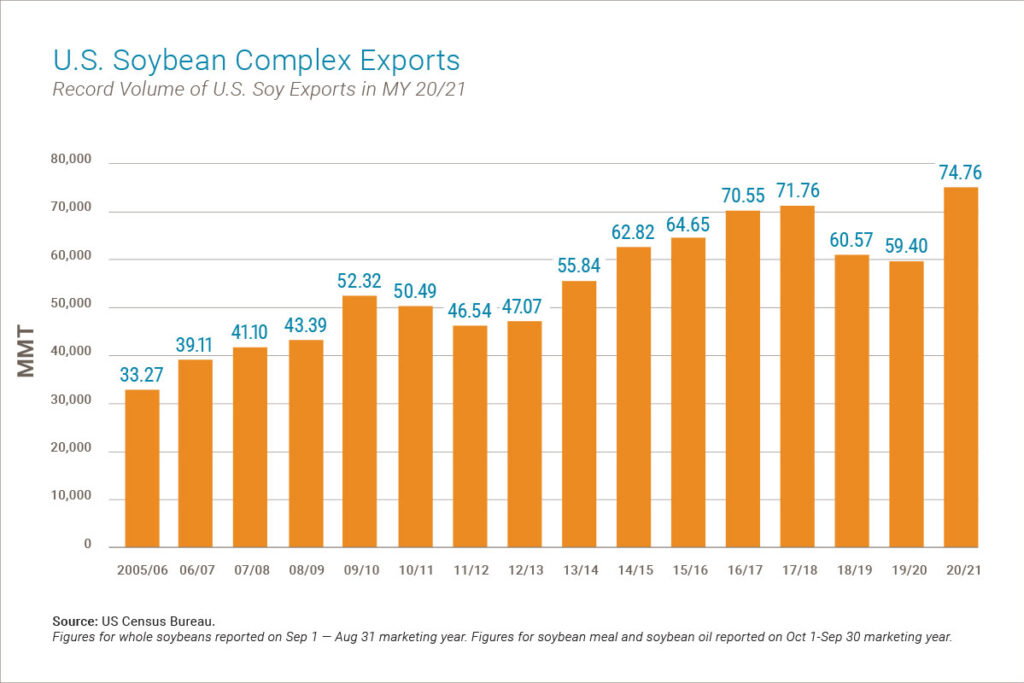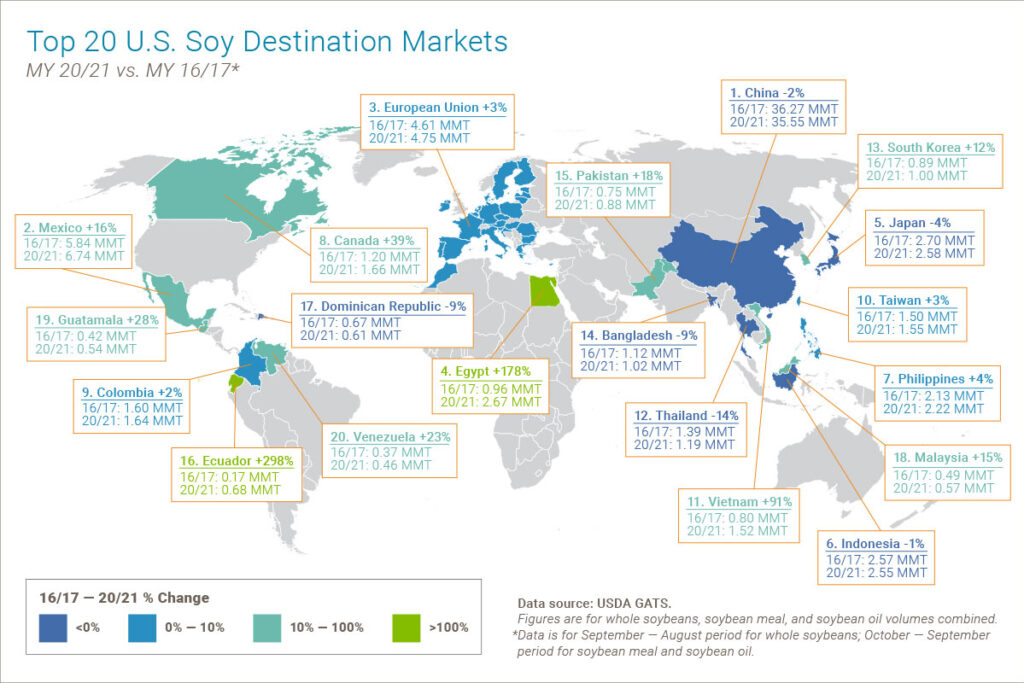
U.S. Soy Achieves Record Export Volume for 20/21 Marketing Year
PRESS RELEASE

Aggregate volume hits record for all international exports, highlighting the positive impact of U.S. Soy’s diversification and expansion strategy to meet the world’s nutrition needs
ST. LOUIS (Dec. 2, 2021) — U.S. Soy set a new record for exporting more product in more international markets than ever before, the United Soybean Board, U.S. Soybean Export Council and American Soybean Association announced today. During the 20/21 market year, a record 61.65 MMT of whole soybeans shipped to markets across the globe, at a value of over $28B in revenue for the U.S. Soy industry. The volume boost is the result of strategic efforts to diversify international markets and distribute more U.S. Soy globally.
“This record is a result of efforts to enhance access and usage of U.S. Soy across the food, feed and livestock industries and across international markets by the U.S. Soy farmers and industry, our customers, and governments around the world,” said Jim Sutter, CEO of U.S. Soybean Export Council (USSEC). “Setting the new aggregate volume record demonstrates the value of the investment of U.S. Soy farmers to create positive impact for our customers around the world to contribute to improved nutrition and food security, environmental sustainability, and livelihoods globally.”
The U.S. Soy industry achieved high export results across the board this year. U.S. Soy shipped 74.76M metric tonnes of total soybean complex, valued at more than $34B (based on Sep-Aug for whole beans, and Oct-Sep for soybean meal and oil). International markets purchased 12.3M metric tonnes of soybean meal and approximately 781,766 metric tonnes of soybean oil. A large part of this success is due to the resources and education in which the soy checkoff has invested over the years. One example is the U.S. Soy Dare to Compare marketing campaign, which highlighted the superior nutritional value, oil quality, and sustainability of U.S. Soy to our industry customers and enabled informed, data-driven product development and supply chain decisions. Another example is USSEC’s Soy Excellence Centers in Egypt, Honduras, Nigeria, Singapore, and Thailand, which provide world-class workforce training and capacity building within the soy value chain to enable local visions for health, nutrition, and environmental sustainability in collaboration with diverse food and agriculture stakeholders.
“The global results are an amazing accomplishment for U.S. Soy farmers, who support the checkoff, and partnerships with industry and governments around the world,” said USSEC Chairman, ASA Director and North Dakota soybean farmer Monte Peterson. “Seeing the rising demand for sustainable protein and sustainable U.S. Soy and knowing that we’re able to reliably provide high-quality, sustainable products to more people and places around the world is incredibly fulfilling. Farmers spend our lives growing these crops and care deeply about the families and communities in which we live and those around the world. I’m excited about the innovations, partnerships, and impacts we are realizing now and what comes next for U.S. Soy in 2022.”
The new aggregate volume record reflects efforts to diversify and expand markets and usage. As additional importers and companies focus on value, the demand for high-quality soybeans continues to grow, driving U.S. Soy forward as a premium, sustainable protein. This increase in demand has led to U.S. Soy acting as a primary solution for protein demand worldwide, producing growth in several markets. For the 20/21 market year, nearly half of U.S. Soy destination markets grew by at least 10% compared to the 16/17 marketing year which was the prior record year for whole soybean exports. Examples of notable growth when comparing the 20/21 and 16/17 marketing years include: 178% in Egypt, 298% in Ecuador, 91% in Vietnam, 18% in Pakistan, and 28% in Guatemala. U.S. Soy maintained a diverse market distribution balance to ensure stability and facilitate future market growth.
“This market year was truly a triumph for sustainable, high-quality U.S. Soy,” said Mac Marshall, USB and USSEC vice president of market intelligence. “These results are reflective of the forward-thinking strategy and dedication of the U.S. Soy industry as a leader in enabling the positive impact and success of our customers around the world.”

###
About the United Soybean Board: United Soybean Board’s 78 volunteer farmer-directors work on behalf of all U.S. soybean farmers to achieve maximum value for their soy checkoff investments. These volunteers invest and leverage checkoff funds in programs and partnerships to drive soybean innovation beyond the bushel and increase preference for U.S. soy. That preference is based on U.S. soybean meal and oil quality and the sustainability of U.S. soybean farmers. As stipulated in the federal Soybean Promotion, Research and Consumer Information Act, the USDA Agricultural Marketing Service has oversight responsibilities for USB and the soy checkoff. For more information on the United Soybean Board, visit unitedsoybean.org.
About the American Soybean Association: ASA represents U.S. soybean farmers on domestic and international policy issues important to the soybean industry. ASA has 26 affiliated state associations representing 30 soybean-producing states and more than 500,000 soybean farmers. More information at soygrowers.com.
About the U.S. Soybean Export Council: The U.S. Soybean Export Council (USSEC) is focused on building preference, improving the value, and enabling market access for the use of U.S. Soy for human consumption, aquaculture, and livestock feed in 82 countries across the world. USSEC is a non-profit organization and dynamic partnership of U.S. soybean producers, processors, commodity shippers, merchandisers, allied agribusinesses, and agricultural organizations; and connects food and agriculture industry leaders through a robust membership program. USSEC is farmer-funded by checkoff funds invested by the United Soybean Board, various state soybean councils, the food and agriculture industry, and the American Soybean Association’s investment of cost-share funding provided by U.S. Department of Agriculture’s (USDA) Foreign Agricultural Service (FAS). To learn more, visit www.dev-ussec-migration.pantheonsite.io and www.ussoy.org, and engage with us on LinkedIn, Twitter, Facebook channels, and U.S. Soy’s LinkedIn, Twitter, Facebook, Instagram and YouTube channels.
Media Contacts:
Paul Murphy-Spooner
United Soybean Board
636.681.1254 I 515.975.6584 I pmurphyspooner@unitedsoybean.org
Chris Samuel
U.S. Soybean Export Council
636.449.6400 I csamuel@ussec.org
Wendy Brannen
American Soybean Association
wbrannen@soy.org